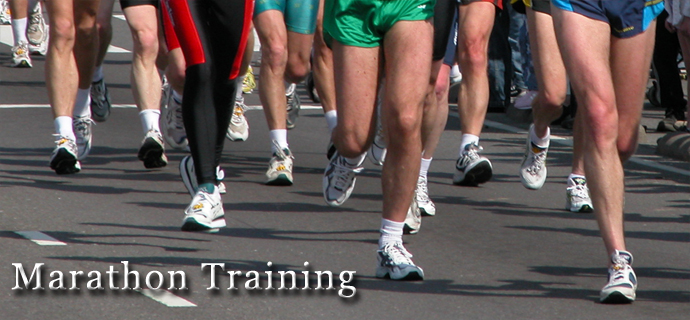
Marathon Training
Growing up I was never a distance runner. I was a sprinter and a jumper better suited for short burst of speed. I never thought of myself as a runner and a marathon seemed entirely out of reach. As I began doing several mud runs at 30 years old, the spirit of competition made me want to push myself to bigger challenges. A little prodding from coworkers and friends started me on the road to this marathon.
When I decided to run this race, I was fairly confident that my cardio and muscle endurance could get to where it needed to be for a successful race. The big concern in my mind was whether or not my joints could keep up with the demands of increasing mileage in such a short time. Though I had been running 3 miles routes regularly for over a year, I had never run more than fives miles at a time. Reaching the pinnacle of endure races in just over 12 weeks would be difficult. I didn’t approach training as a runner preparing for a race but instead as an adventurer seeking a challenge.
Marathon Training Program
Most of the marathon training schedules I found online were designed for 18-22 weeks. The concept of extending long run distances but also backing off to allow for recovery was important so when adjusting the schedule, I tried to trim earlier weeks to maintain the structure of the later weeks. I settled in on the following plan:
Knowing that I was working on a truncated marathon training program already, I tried to stick to the schedule as closely as possible. I never skipped a long run and only skipped a couple short runs to allow for injury recovery. Sticking to the schedule at all costs meant I was often running in the dark or in the rain. The 12 week marathon training schedule was a good motivator that kept me moving.
That motivation to run was important because it helped me train through several running injuries. Adjusting to the onset of one injury seemed to lead into another. With some stretching, icing and massage I was able to overcome most injuries in less than a week. I also went to a local running store to be fitted for some proper running shoes. They recognized my arch needed additional support by watching me walk barefoot around the store. They brought me several options to try on and once we found a good fit in the Mizuno Wave Inspire 7 running shoes, they recorded me as I ran on a treadmill to review the stability of my steps.
Running Hydration and Nutrition
Being new to distance running, I really underestimated the importance of hydration and calorie replacement. My first 9 mile run was in 90 degree heat with high humidity with nothing but a single water fountain along the way. After running the half marathon, I picked up a simple Chums Water belt. It holds a single 20 ounce bottle and can hold 3-4 energy gels. It was a cheap solution but got the job done and didn’t bounce around much.
I tried several different running nutrition options. I started with GU brand
energy gels and found the fruit flavors more palatable than
vanilla/chocolate flavors which taste like a salty stale frosting.
My favorite was the Citrus flavored Clif Shot Gel which I
learned to enjoy. They have gels both with and without caffeine.
I’ve heard mixed reviews about the effectiveness of caffeine
while running. I generally avoid caffeine in my day to day
life but wasn’t opposed to running with it. Flavor was the
deciding factor for me and the Citrus flavor happened to have
caffeine. I figured the running distance was unpleasant enough
without forcing down some goop that didn’t taste good. I also
tried the Clif Shot Bloks which were pleasant tasting but
I liked the small size and ease of use of the gels. They can
be pretty pricy if bought individually so your best bet is
to find a flavor you like then buy them by the box online.
I would use my first gel 45 minutes into a run and then I would use them every thirty minutes after that. It’s important to drink plenty of water after consuming anything while running. It’s also good to train with whatever sports drinks, gels or snacks that you plan to use during your race so you are accustom to them and know how your body will react. Often your race gear bags will come with freebies but I usually save those for training runs. Mile 20 isn’t the time you want to learn that a new brand of gel upsets your stomach.
After running, it’s important to eat some carbohydrates to rebuild glycogen stores. There is a 30 minute window after the run where this is most effective. Protein can also be helpful to accommodate muscle development.
Running Routes
Choosing your running routes is an important part of marathon training. Ideally, your training routes should mimic the terrain of your marathon course. Living near Chicago, it wasn’t easy finding routes to help prepare for the notoriously hilly Wisconsin Dells marathon. Sometimes park trails and forest preserves offer more elevation changes than the road routes. As a bonus, dirt or crushed limestone trails save some wear and tear on your joints. Most of my long runs were spent at the Waterfall Glen Forest Preserve in Darien, IL. With an outside trail of about 10 miles, with clear mile markers it was easy to get in the distance needed. Alternating running the route both clockwise and counterclockwise helps vary the terrain even more. Two nicely spaced water points let me refill my water bottle on the trail.
Because of the volume of running required during the marathon training program, it wasn’t always convenient to drive out to a forest preserve. Using Google Maps to plot a couple routes around the neighborhood is a good option for efficient running. It’s best to avoid major streets for safety but also because getting stuck by traffic and stoplights can really break your rhythm.
I usually ran alone but running with a group can be useful and often have routes already planned. Running groups can be useful to help you push your pace, learn from more experienced runners and keep your accountable when it comes to sticking to your training plan. Running with others can also help pass the time during some of those long runs. If running alone, many people like to run with music. Some marathons don’t allow headphones for safety reasons. I tried running with music once but the songs I hoped would pump me up just sounded like noise when I was used to hearing nothing but the sound of my breath and footfalls.
Stretching
The theories on stretching have changed a bit over the years and people have challenged the idea that static stretching before exercise reduces injury. More people are favoring dynamic stretches before workouts. Flexibility is important for maintaining a balanced and stable running form. Running with tight muscles can lead to poor form and strained tendons. Deep tissue massage or foam rollers prior to stretching can help release adhesion that tighten up muscles and fascia. Icing after stretching and running will help reduce inflammation and allow for faster recovery.
Cross Training and Rest Days
Most marathon training programs have cross training days and rest days built into the schedule. Cross training with biking, swimming and other sports helps you continue to build cardio fitness while changing up the muscles worked. Rest days are critical to allow your muscles a chance to rebuild and injuries to heal. It’s still good to stick with a good stretching regimen on rest days.
When focused in on reaching your goals, it can be tempting to skip rest days to push yourself but overtraining won’t get you to 26.2 miles any faster.
Marathon Training Taper
Marathon training schedules should also have a built in taper period to reduce mileage and allow for recovery so that you have peak performance on marathon day. With the longest runs behind you, the taper period is a mental challenge. At this point, you have to trust in your training and resist the urge to squeeze in extra miles. During the taper period there isn’t enough time to make any significant conditioning gains. The marathon taper period is all about letting your body recover from the weeks of hard miles while doing just enough to keep yourself loose and ready for race day.
A Final Note
Before I ran a marathon, I had friends who claimed they didn’t consider themselves runners even after taking on the 26.2 mile race. It never made sense to me since I assumed anyone who could run that long would automatically be in peak physical condition with incredibly low resting heart rates and no body fat. Now that I have completed a marathon, I see where my friends were coming from. I’m definitely in better shape after completing the training and the race but there were no dramatic changes. Instead, it felt like I had just trained my body to do a very specific action (running at a 10 minute mile pace) for very long time. If I start sprinting in a mud run or swimming in a pond, I still feel like I get winded relatively quickly. The rigors of marathon running don’t automatically translate to universal fitness. Experienced runners will work in more diverse workouts and more cross-training to develop a type of physical conditioning that will apply to more activities.
I also strongly believe that pretty much anyone can complete a marathon if they’re willing to put in the time. Be wary of programs that promise to get you from the couch to a marathon in a short period of time – they can vary from risky to reckless. Everything about your body needs time to adapt to the demands of increased mileage. Your heart needs to get stronger, your body will produce more red blood cells, your tendons, muscles and joints all need to adapt. If you have a good foundation of running shorter distances, a couple months of building your long runs will probably get you there. If you’ve never run a mile before, you might have a year or two of training ahead of you but if you commit yourself to your goal, running a marathon is achievable.
|
